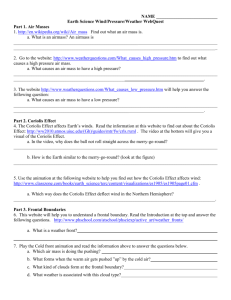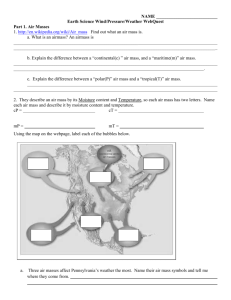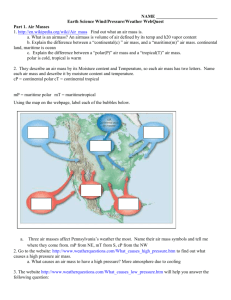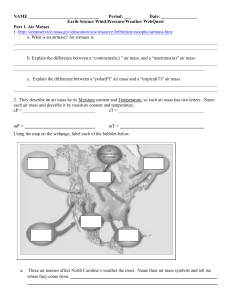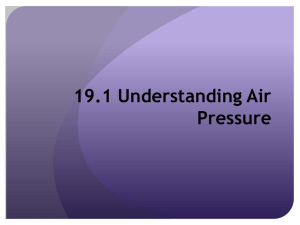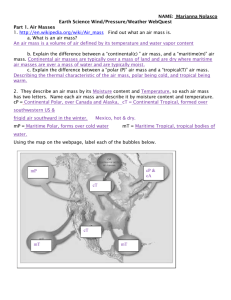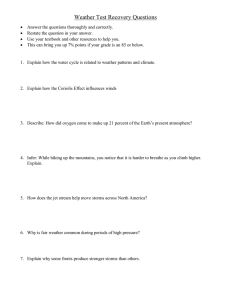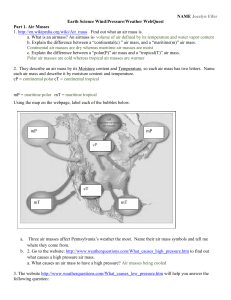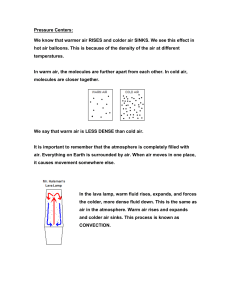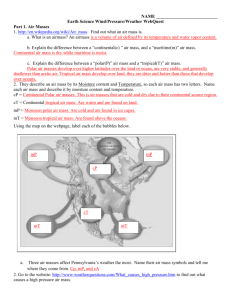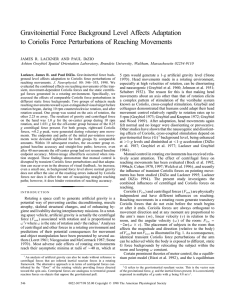Weather WebQuest
advertisement
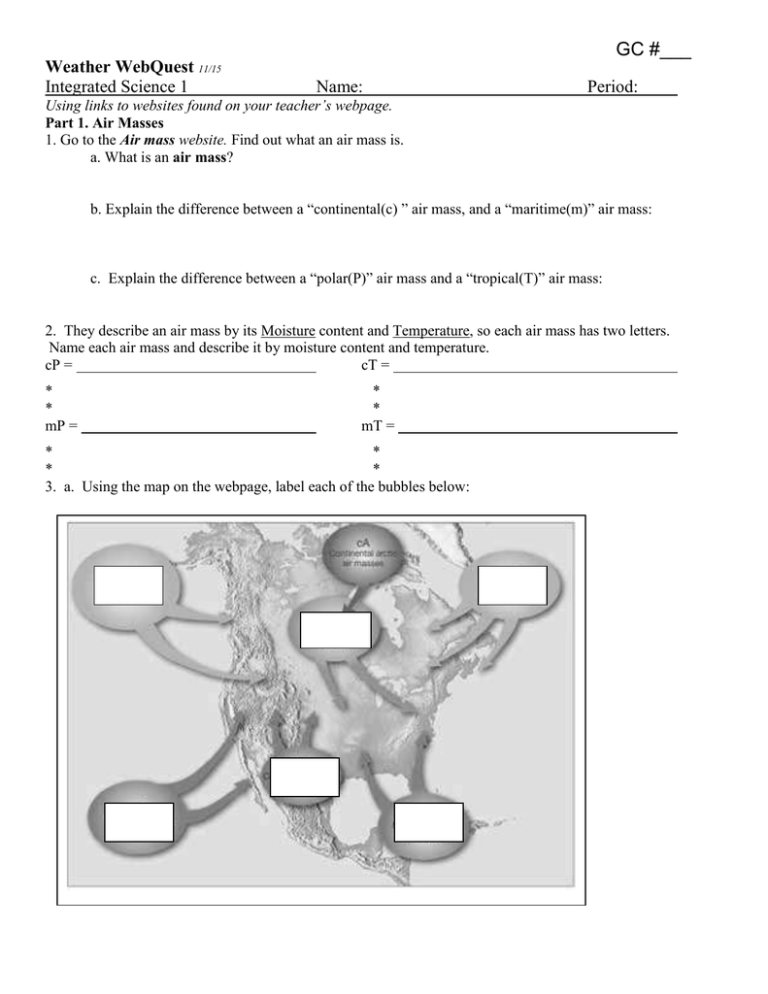
Weather WebQuest 11/15 Integrated Science 1 GC #___ Name: Period: Using links to websites found on your teacher’s webpage. Part 1. Air Masses 1. Go to the Air mass website. Find out what an air mass is. a. What is an air mass? b. Explain the difference between a “continental(c) ” air mass, and a “maritime(m)” air mass: c. Explain the difference between a “polar(P)” air mass and a “tropical(T)” air mass: 2. They describe an air mass by its Moisture content and Temperature, so each air mass has two letters. Name each air mass and describe it by moisture content and temperature. cP = cT = * * mP = * * mT = * * * * 3. a. Using the map on the webpage, label each of the bubbles below: b. Three air masses affect Pennsylvania’s weather the most. Name their air mass symbols and tell me where they come from. 4. a. Go to the high pressure website to find out what causes a high pressure air mass. What causes an air mass to have a high pressure? b. Go to the low pressure website, it will help you answer the following question: a. What causes an air mass to have a low pressure? c. Go to the wind website Does air move from high pressure to low, or low to high? Part 2. Global Winds 5. a. Go to the global winds website What are the Global Winds? b. Label B – L in the diagram below. Part 3. Coriolis Effect 6. Go to the Coriolis Effect website. See how the Coriolis Effect affects Earth’s winds. The video at the bottom will give you a visual of the Coriolis Effect. a. In the video, why does the ball not roll straight across the merry-go-round? b. How is the Earth similar to the merry-go-round? (look at the figure) c. Wind is an object that is affected by the Coriolis Effect. What happens to winds in the Northern Hemisphere as a results of the Coriolis Effect? d. On the left hand side click on the “Pressure Gradient” link. What is the direction of the net force between two pressure systems? From pressure to pressure. e. Click on the “High” link in the middle of the page. What is a High Pressure Center and what does it mean? 7. Go to the Coriolis Animation website. Use the animation at the following website to help you find out how the Coriolis Effect affects wind: a. Which way does the Coriolis Effect deflect wind in the Northern Hemisphere? Part 4. Pressure Centers and Weather 8. Go to the Surface website. Then, find the picture that says “Sea Level Pressure with IR satellite”. Click on this figure to bring up a new window. Answer the following questions: a. This map shows you isobars and cloud cover. Click on the ? help to explain what an isobar is. What is an isobar? b. Look at the map and find Chicago. Between which two isobars is Chicago? c. Click on the button that says “Aminate”. Choose “96 frames”. Press “Play” on the window, and watch where the clouds travel. Do the clouds tend to be near High pressure centers (H) or Low pressure centers? 9. Go to the highlow website. It will help explain why High pressure centers usually mean good weather, and Low pressure centers usually mean bad weather. Go here and read to discover why this is true, and then answer the following questions: a. Air descends (comes down) at High pressure areas. Why does descending air not allow for clouds to form? b. Air ascends (goes up) at Low pressure areas. Why does ascending air allow for clouds to form? d. Use diagram to determine the direction of wind motion. What is the direction around a High pressure system? d. What is the direction around a Low pressure system? Part 5. Frontal Boundaries 10. Go to the fronts website to understand a frontal boundary. Read the Introduction at the top and answer the following questions. a. What is a weather front? 11. Play the Cold front animation and read the information above to answer the questions below. a. Which air mass is doing the pushing? b. What forms when the warm air gets pushed ”up” by the cold air? d. What weather is associated with this cloud type? 12. Play the Warm Front animation and answer the questions below. a. Which air mass is doing the pushing? b. What forms when the warm air rides “up” over the cold air? d. What kind of clouds are at the very front edge of this boundary? 13. Below you will see on the weather map the symbol for a Cold Front is a Blue line with Triangles and a Warm Front is a Red line with half-circles. Label the diagram to show where the cool, dry (cP) air mass and the warm, moist (mT) air mass is in the picture. a. Along which frontal boundary will thunderstorms develop? b. Along which frontal boundary will all-day rain occur? c. Look at the wind arrows on the diagram, do they match the direction of motion you determined in questions 9, d? What direction is that? 14. What happens at a Stationary Front? 15. Search the internet to find out the weather map symbol for a Stationary Front and draw below. 16. Go to the maps website to see the Current Weather Map. a. Where is a Cold Front occurring? b. Where is a Warm Front occurring? c. What type of air mass are we currently in?
